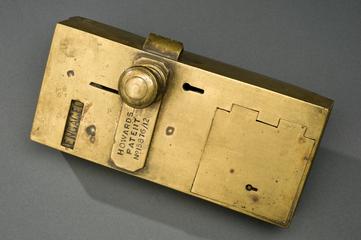




Small wooden box, to hold lymph from calves after inoculation, used by Army Vaccine Institute, English, 1900-1910
After calves had been inoculated with smallpox, the lymph containing white blood cells which fight against disease are extracted and preserved in capillary tubes. The lymph could then be used to vaccinate people against smallpox. Calf lymph replaced the human kind in 1898 as human lymph spread other infections, such as syphilis.
The Army Vaccine Institute in Aldershot used this box to store lymph. The Institute produced enough calf lymph to inoculate 126,280 people a year. This was not without its dangers. For example, in 1906 questions were asked in the House of Commons following the post-vaccination deaths from blood poisoning of a small number of army recruits.
Details
- Category:
- Public Health & Hygiene
- Collection:
- Sir Henry Wellcome's Museum Collection
- Object Number:
- A602779
- Materials:
- wood
- Measurements:
-
overall: 38 mm x 120 mm x 57 mm, .04kg
- type:
- box
- credit:
- Bruce, A.N.




